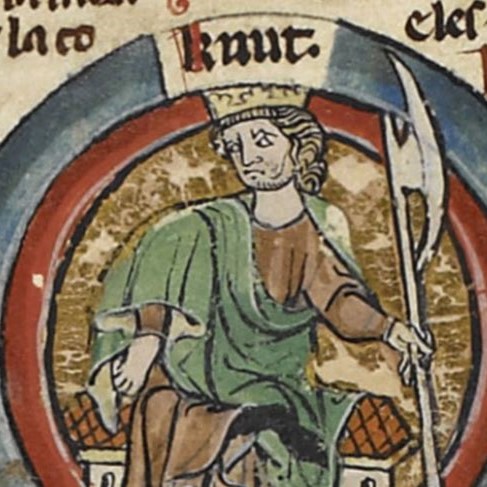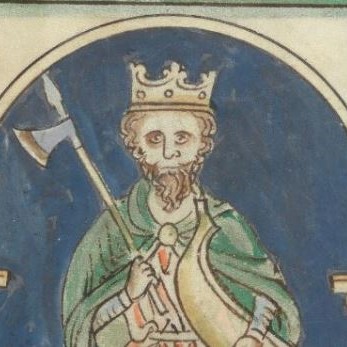In the early 11th century, England faced a storm from the north. Viking raids had long terrorised the English coast. But by 1013, these attacks became something more—an invasion led by a Danish king.
From this chaos rose Cnut the Great. A Viking prince. A war leader. And eventually, king not only of England, but of Denmark and Norway too.
Cnut’s story is one of brutal conquest, political mastery, and unexpected transformation. He began as an outsider. He ended as one of the most powerful Christian monarchs in Europe.
1. The Rise of Cnut
Cnut was born into Danish royalty. His father, Sweyn Forkbeard, was a feared Viking warlord who became king of Denmark around 986. Sweyn launched raids across the North Sea, targeting England, and by the early 11th century, he aimed to conquer it outright.
In 1013, Sweyn’s forces invaded England. King Æthelred II, often called “the Unready,” was deeply unpopular. Years of internal strife, failed military campaigns, and heavy taxation had weakened his rule. During this time, many English nobles began submitting to the Danes.
Cnut, likely in his late teens or early twenties, joined Sweyn during this decisive campaign. It was a formative experience—his first major taste of war and leadership.
By the end of 1013, Sweyn controlled most of England and Æthelred fled into exile in Normandy. But the victory was short-lived.
However, in early 1014, Sweyn died unexpectedly and Cnut was left in charge of the Danish army.
Despite his efforts, the English nobility invited Æthelred back to reclaim the throne. Cnut had to retreat—but he didn’t give up.
He returned to Denmark briefly to rebuild his strength. During this period, Cnut began forming crucial alliances. One of the most important was with Ælfgifu of Northampton, a powerful noblewoman from the English Midlands. Through her, Cnut gained local support in central England, and vital territory for any would-be king.
In 1015, Cnut launched a new invasion. This time, he came with the intention to rule.
2. Defeating Edmund Ironside
England was once again thrown into civil war.
Æthelred died in April 1016 and his son, Edmund Ironside, became king. Edmund was young, brave, and determined to provide strong resistance against Cnut’s forces.
What followed was a brutal campaign. The two men fought at least five major battles. At first, victories were mixed. Edmund won at Brentford; and Cnut responded by defeating him at Ashingdon (also known as Assandun), in Essex, in October 1016.
Ashingdon was the turning point. Edmund’s army was weakened, and he was possibly wounded during this battle. In contrast, Cnut’s position had strengthened. But still, the war had taken its toll on both sides.
Rather than risk further destruction, the two kings agreed to divide England.
Under their agreement, Cnut would rule all of England north of the Thames, while Edmund would keep Wessex—the ancient heartland of the English crown.
But fate soon intervened. Just weeks later, Edmund died—possibly from battle wounds, possibly from assassination. With Edmund gone, Cnut assumed full control of England. At just around 21 years old, he was now King of all England.
3. The Viking Becomes King
Cnut had seized the throne by force, but he knew he would need more than a sword to keep it.
He was still a foreigner and many in England saw him as the leader of a heathen army, even though he had been baptised.
So Cnut made a critical choice: he would rule not as a Viking warlord, but as a Christian king in the Anglo-Saxon tradition.
Cnut presented himself as a legitimate heir to the English monarchy. He worked closely with English church leaders, especially Archbishop Wulfstan of York, one of the most influential figures in the kingdom at the time.
Wulfstan had previously written laws for Æthelred, but now, he helped Cnut create a new legal code that stressed justice, stability, and Christian piety. These laws showed that Cnut understood English traditions and was willing to uphold them.
Cnut also maintained many Anglo-Saxon institutions.
He kept leading English nobles in place rather than replacing them with Danes. This helped maintain continuity and earned him support across different regions.
Importantly, Cnut made generous donations to the Church. He supported monasteries and religious houses. He even made a pilgrimage to Rome in 1027—a rare act for a northern king. It was a public display of piety and a sign that Cnut wanted to be seen not just as a ruler, but as a Christian monarch accepted by the wider European world.
4. Ruling the North Sea Empire

Cnut’s power continued to grow after his conquest of England.
In 1018, his brother Harald died, and Cnut became King of Denmark. A few years later, he also added Norway to his realm—though ruling Norway proved more difficult and unstable.
By the mid-1020s, Cnut ruled an empire that stretched across the North Sea. This “North Sea Empire” linked England, Denmark, and Norway under a single crown and for a brief time, Cnut was one of the most powerful kings in Europe.
But his rule was not just about conquest. Cnut was a skilled administrator and politician. He travelled between his kingdoms. He appointed regional leaders and He balanced the interests of both English and Danish nobles.
Despite his Viking roots, Cnut proved to be a king of vision and adaptability.
5. Final Thoughts on Cnut
Cnut’s rise from Viking invader to King of England is one of the most remarkable stories of the early medieval period.
He began as the son of a warlord. He came to England with a fleet and through military success, political alliances, and religious reform, he transformed his image.
Cnut didn’t just conquer England—he learned to govern it.
He embraced English customs, strengthened the role of the Church, and united different peoples under one rule. By the end of his reign, he was not just accepted by the English—he was admired.
Cnut ruled England until his death in 1035, and although his empire didn’t last long after his death, his reign marked a turning point: the moment when the age of Viking invasions gave way to a new, more unified northern Europe.
Further Reading
If you enjoyed this article, you may enjoy these:
- Blood on St. Brice’s Day: Æthelred’s Viking Massacre
- Emma of Normandy: Queen, Pawn, and Power Broker
- The Fear of the Year 1000: Apocalyptic Anxieties
- Tribute or Treason? Æthelred’s Gamble with the Vikings
- The Anglo-Saxon State: How England Built Europe’s Most Centralized Medieval Government
- What happened to Edgar the Aetheling?
- Kings and Queens of England Ranked from Worst to Best
- How did Charlemagne improve the lives of people in Europe?
- Why was the crowning of Charlemagne so important?






